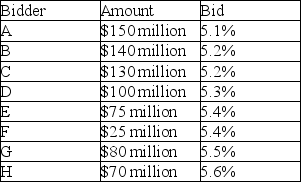Suppose that an issuer is offering $600 million of a bond issue, and nine bidders submit the following yield bids: 
Which of the below statements is FALSE?
A) The first five bidders (A, B, C, D, and E) will be allocated the amount for which they bid because they submitted the lowest-yield bids. In total, they will receive $595 million of the $600 million to be issued.
B) After allocating $420 million to the highest three bidders, then $180 million can be allocated to the next two highest bidders.
C) The lowest bidders will receive an amount proportionate to the amount for which they bid.
D) After allocating $595 million to the highest bidders, then $5 million can be allocated to the next lowest bidders.
Correct Answer:
Verified
Q1: Which of the below statements is FALSE?
A)
Q2: The _ involves the distribution to investors
Q3: In a variant of the auction process,
Q5: A red herring is _.
A) a period
Q6: Not all deals are underwritten using the
Q7: Underwriting activities are regulated by the _.
A)
Q8: Which of the below statements is FALSE?
A)
Q9: The traditional process in the United States
Q10: The Securities Act of 1933 _.
A) does
Q11: When all bidders buy the amount allocated
Unlock this Answer For Free Now!
View this answer and more for free by performing one of the following actions

Scan the QR code to install the App and get 2 free unlocks

Unlock quizzes for free by uploading documents